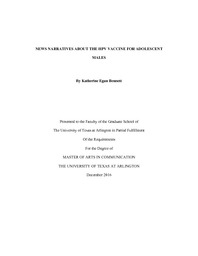
ATTENTION: The works hosted here are being migrated to a new repository that will consolidate resources, improve discoverability, and better show UTA's research impact on the global community. We will update authors as the migration progresses. Please see MavMatrix for more information.
Show simple item record
| dc.contributor.advisor | Harp, Dustin | |
| dc.creator | Bennett, Katherine E | |
| dc.date.accessioned | 2017-02-14T16:06:40Z | |
| dc.date.available | 2017-02-14T16:06:40Z | |
| dc.date.created | 2016-12 | |
| dc.date.issued | 2016-12-08 | |
| dc.date.submitted | December 2016 | |
| dc.identifier.uri | http://hdl.handle.net/10106/26402 | |
| dc.description.abstract | The goal of this research was to examine portrayals of gender roles and
expectations related to the human papillomavirus (HPV) vaccine for men and boys in U.S. newspapers within the theoretical framework of feminist theory, feminist media theory, hegemonic masculinity, and heteronormativity. Since the
HPV vaccine was approved for girls in women in 2006, research has been
conducted examining media portrayals of the HPV vaccine for girls and women, but little has been written about how the news has treated the subject for men and boys. This research examined print newspaper articles between 2011, when the
U.S. Advisory Council on Immunizations Practices (ACIP) first recommended the HPV vaccine for routine vaccination in boys and men ages 9 to 21 in addition to women and girls 9 to 26, through to June 2016, to allow six months analysis after the ACIP expanded its recommendation to also include men ages 21 to 26, to examine how the news on the vaccine portrayed gender roles and expectations.
During this thematic textual analysis of 124 articles, several important
themes were uncovered. Overall, boys and men are still treated as an afterthought to the discussion on HPV and the HPV vaccine, with much of the discussion still focused on cervical cancer. Other themes include an increased focus on oral cancer (12.9 percent of articles), acceptance of riskier sexual behavior for men (4
percent), vaccine mandate focused on civil liberties (4 percent), overlooking side effects of the HPV vaccine on men and boys (25.8 percent), and the idea that men should receive the HPV vaccine as a way to protect their female partners (3.2 percent). There also remains a heteronormative emphasis in the newspaper
portrayals with only 4.8 percent of articles mentioning that men who have sex with men (MSM) are at significantly higher risk of developing some HPV-related cancers. | |
| dc.format.mimetype | application/pdf | |
| dc.language.iso | en_US | |
| dc.subject | HPV | |
| dc.subject | HPV vaccine | |
| dc.subject | Gender norms | |
| dc.subject | Heteronormativity | |
| dc.subject | Feminist media theory | |
| dc.subject | Hegemonic masculinity | |
| dc.title | NEWS NARRATIVES ABOUT THE HPV VACCINE FOR ADOLESCENT MALES | |
| dc.type | Thesis | |
| dc.degree.department | Communication | |
| dc.degree.name | Master of Arts in Communications | |
| dc.date.updated | 2017-02-14T16:08:48Z | |
| thesis.degree.department | Communication | |
| thesis.degree.grantor | The University of Texas at Arlington | |
| thesis.degree.level | Masters | |
| thesis.degree.name | Master of Arts in Communications | |
| dc.type.material | text | |
| dc.creator.orcid | 0000-0001-8094-9176 | |
Files in this item
- Name:
- BENNETT-THESIS-2016.pdf
- Size:
- 467.5Kb
- Format:
- PDF
This item appears in the following Collection(s)
Show simple item record


